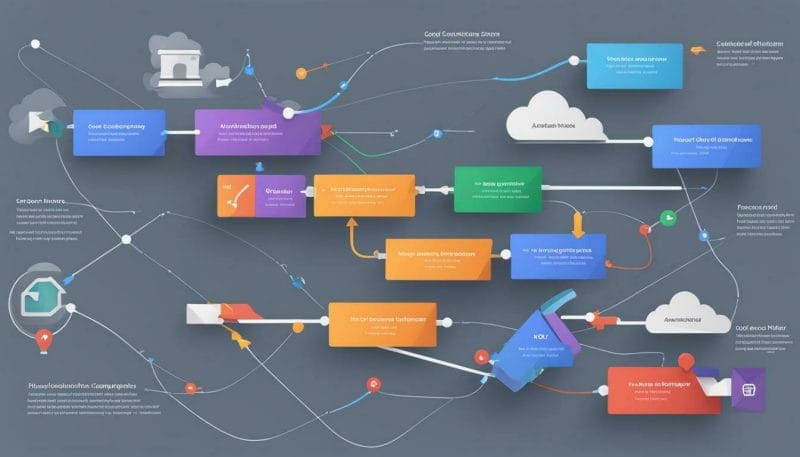Wondering when Google Ads is linked to Google Analytics? At Loudachris Digital Marketing, we have the expertise to guide you through the integration process. When these two powerful platforms are connected, businesses can gain valuable insights and enhance their digital marketing efforts. Google Ads offers precise targeting and cost-effective advertising, while Google Analytics provides comprehensive analytics to measure campaign success.
By linking Google Ads to Google Analytics, you can track the performance of your ads and analyze data for better campaign optimisation. This integration allows you to understand your target audience, choose relevant keywords, craft compelling ad copy, and optimise landing pages to drive better results.
Key Takeaways:
- Linking Google Ads to Google Analytics provides valuable insights for campaign optimisation.
- Google Ads allows for precise targeting and cost-effective advertising.
- Google Analytics provides comprehensive analytics to measure campaign success.
- Best practices for effective Google Ads campaigns include understanding the target audience, choosing relevant keywords, and crafting compelling ad copy.
- Regularly monitor and adjust campaigns based on performance metrics like click-through rate, conversion rate, and return on investment.
The Benefits of Linking Google Ads and Google Analytics
Linking Google Ads with Google Analytics offers a range of benefits, including the ability to track and analyze the performance of your ads in a more comprehensive manner. Loudachris Digital Marketing can help you leverage this powerful integration to optimise your digital marketing efforts and drive business growth.
By connecting Google Ads to Google Analytics, you gain access to valuable data that can provide insights into the effectiveness of your ad campaigns. You can track metrics such as impressions, clicks, conversions, and revenue, allowing you to understand the true impact of your advertising efforts. With this information, you can make data-driven decisions to enhance your campaigns and improve overall performance.
| Benefits of Linking Google Ads and Google Analytics |
|---|
| Comprehensive tracking of ad performance |
| Access to in-depth analytics and audience insights |
| Ability to measure the ROI of your advertising campaigns |
| Opportunity to optimise campaigns based on data-driven insights |
Furthermore, by integrating Google Ads with Google Analytics, you can take advantage of advanced features to fine-tune your campaigns. This includes tracking user behavior on your website through conversion tracking, analyzing multi-channel attribution to understand the impact of different marketing channels, and utilising automated insights to identify opportunities for campaign improvement.
With the expertise of Loudachris Digital Marketing, you can harness the full potential of linking Google Ads and Google Analytics. Our team of professionals understands the intricacies of these platforms and can help you develop strategies that align with your business goals. Whether you are a conveyancer looking to reach potential clients or a business in any other industry, we have the knowledge and experience to drive your digital marketing success.

Creating effective Google Ads campaigns requires a strategic approach and adherence to best practices that include understanding your target audience, selecting the right keywords, and crafting compelling ad copy. By following these guidelines, you can maximise the performance of your Google Ads campaigns and drive better results for your business.
Understanding Your Target Audience: Before launching a Google Ads campaign, it is essential to have a clear understanding of your target audience. Conduct thorough market research to identify their demographics, preferences, and pain points. This information will help you tailor your campaign messaging and targeting options to resonate with your audience and increase the likelihood of engagement and conversions.
Selecting the Right Keywords: Keywords play a crucial role in the success of your Google Ads campaigns. Conduct keyword research to identify relevant, high-performing keywords that align with your audience’s search queries. Use tools like Google Keyword Planner to explore keyword ideas and assess their search volume and competition. Incorporate a mix of broad match, phrase match, and exact match keywords to optimise your campaign’s reach and relevance.
Crafting Compelling Ad Copy: Your ad copy is the first impression you make on potential customers, so it’s crucial to make it compelling and persuasive. Highlight your unique selling propositions, include strong calls-to-action, and use relevant keywords in your ad text. Aim for a clear and concise message that captures your audience’s attention and entices them to click on your ad. Regularly test and optimise your ad copy to improve its performance over time.
| Benefits | Metrics |
|---|---|
| Increase brand awareness | Impressions, click-through rate |
| Generate leads | Conversion rate, cost per conversion |
| Drive website traffic | Clicks, bounce rate |
Quote:
“A successful Google Ads campaign requires a deep understanding of your target audience, strategic keyword selection, and captivating ad copy that grabs attention. By implementing these best practices, you can create campaigns that deliver optimal results and drive business growth.”

Regularly monitoring key performance metrics such as click-through rate, conversion rate, and return on investment is essential for ensuring the success of your Google Ads campaigns. By keeping a close eye on these metrics, you can identify areas for improvement and make data-driven decisions to optimise your campaigns.
When it comes to click-through rate (CTR), this metric measures the percentage of users who click on your ads out of the total number of impressions. A high CTR suggests that your ad copy is engaging and relevant to your target audience. To improve CTR, consider adjusting your ad headlines and descriptions, incorporating strong calls-to-action, and testing different ad formats.
Conversion rate is another critical metric that determines the percentage of users who take a desired action on your website, such as making a purchase or filling out a lead form. By tracking conversion rate, you can gain insights into the effectiveness of your ads and landing pages. If you notice a low conversion rate, try optimising your landing pages, simplifying your conversion process, and refining your targeting to reach a more relevant audience.
Return on investment (ROI) is a key metric that measures the profitability of your Google Ads campaigns. It takes into account the cost of your ads and the revenue generated from those ads. To calculate ROI, divide your revenue by your ad spend and multiply the result by 100 to get a percentage. If you find that your ROI is not meeting your expectations, consider adjusting your bidding strategy, targeting specific keywords with higher conversion rates, or refining your ad messaging to attract more qualified leads.
| Metric | Definition |
|---|---|
| Click-Through Rate (CTR) | The percentage of users who click on your ads out of the total number of impressions. |
| Conversion Rate | The percentage of users who take a desired action on your website, such as making a purchase or filling out a lead form. |
| Return on Investment (ROI) | The profitability of your Google Ads campaigns, calculated by dividing revenue by ad spend and multiplying by 100. |
By regularly monitoring and adjusting your campaigns based on these performance metrics, you can optimise your Google Ads strategy for better results. Remember to test different approaches, track the impact of your changes, and make data-driven decisions to continuously improve your campaigns.

- Regularly monitor click-through rate (CTR), conversion rate, and return on investment (ROI) to optimise your Google Ads campaigns.
- Optimize your ad copy, landing pages, and targeting to improve CTR and conversion rate.
- Calculate ROI by dividing revenue by ad spend and multiplying by 100.
- Adjust your bidding strategy, target high-converting keywords, and refine your ad messaging to maximise ROI.
- Make data-driven decisions and continuously test and refine your campaigns for better results.
“Regularly monitoring and adjusting campaign performance based on key metrics is essential for driving success in Google Ads. By optimising click-through rate, conversion rate, and return on investment, businesses can achieve higher ad engagement, increased conversions, and improved profitability.”
Now that we’ve explored the importance of monitoring and adjusting campaigns based on performance metrics, let’s move on to the next section to learn about common mistakes to avoid in Google Ads campaigns.
Common Mistakes to Avoid in Google Ads Campaigns
To avoid potential pitfalls, it’s crucial to be aware of common mistakes businesses make when running Google Ads campaigns, such as not understanding their target audience or neglecting crucial keyword research. These mistakes can hinder the effectiveness of your campaigns and result in wasted resources. Here are some key areas to focus on to ensure you set yourself up for success:
1. Understanding the Target Audience:
One of the biggest mistakes businesses make is not taking the time to truly understand their target audience. Without a clear understanding of your audience’s demographics, interests, and pain points, it becomes challenging to create ads that resonate with them. By conducting thorough market research and leveraging tools like Google Analytics, you can gain valuable insights into your audience’s preferences and tailor your ad messaging to meet their needs.
2. Neglecting Keyword Research:
Keywords form the foundation of your Google Ads campaigns. Neglecting proper keyword research can lead to ads that don’t reach the right audience or fail to generate relevant clicks. Take the time to conduct keyword research to identify the most relevant and high-performing keywords for your business. Use tools like Google Keyword Planner to discover keywords with high search volumes and low competition. It’s also essential to regularly update your keyword lists and adapt them based on performance data.
3. Not Tracking Conversions:
Tracking conversions is crucial for evaluating the success of your Google Ads campaigns. Without proper conversion tracking, you won’t have a clear understanding of how many leads or sales your ads are generating. By setting up conversion tracking in Google Analytics, you can see which keywords, ads, and landing pages are driving the most conversions. This data allows you to make data-driven decisions and optimise your campaigns for better results.
Avoiding these common mistakes is key to running successful Google Ads campaigns. By understanding your target audience, conducting thorough keyword research, and tracking conversions, you can optimise your campaigns for maximum effectiveness and achieve your digital marketing goals.

Optimization Techniques for Google Ads Campaigns
Optimizing your Google Ads campaigns involves various techniques, such as enhancing ad quality, leveraging negative keywords, and ensuring mobile optimisation for an improved user experience. These strategies can significantly impact the success of your digital marketing efforts and help you reach your target audience more effectively. Let’s explore these optimisation techniques in detail:
Enhancing Ad Quality
High-quality ads are more likely to attract the attention of potential customers and generate better results. To enhance ad quality, focus on creating compelling ad copy that highlights unique selling propositions and incorporates strong calls-to-action. Use relevant keywords in your ad content to improve its relevance and increase the chances of appearing in relevant search results.
Leveraging Negative Keywords
Negative keywords play a crucial role in refining your ad targeting and ensuring that your ads are shown to the right audience. By identifying and excluding irrelevant search terms, you can prevent your ads from appearing in unrelated searches, saving your advertising budget for more relevant clicks. Regularly analyze your campaign data to identify irrelevant search terms and add them as negative keywords to optimise your ad targeting.
Ensuring Mobile Optimisation
With the increasing use of mobile devices, it’s essential to optimise your Google Ads campaigns for mobile users. Create mobile-friendly ad formats that adapt well to smaller screens and provide a seamless user experience. Make sure your landing pages are mobile-optimized, load quickly, and have a clear call-to-action. By catering to mobile users, you can maximise your campaign’s reach and engagement.

By implementing these optimisation techniques, you can improve the performance of your Google Ads campaigns and achieve better results. Remember to regularly monitor your campaign metrics, test different strategies, and make data-driven adjustments to continuously optimise your campaigns.
Crafting Effective Ad Copy for Google Ads
Crafting effective ad copy is crucial for capturing the attention of your target audience, and it involves highlighting unique selling propositions, incorporating strong calls-to-action, and appealing to the emotional triggers of potential customers. To create compelling ads that drive results, consider the following strategies:
- Highlight unique selling propositions: Clearly communicate what sets your product or service apart from competitors. Whether it’s a special feature, a discount, or exceptional quality, emphasize the unique benefits that your audience can expect.
- Incorporate strong calls-to-action (CTAs): Encourage your audience to take action by using persuasive and action-oriented language in your CTA. Use verbs like “buy now,” “book today,” or “sign up” to prompt immediate engagement.
- Appeal to the emotional triggers of potential customers: Understand the desires, needs, and pain points of your target audience. Craft your ad copy in a way that resonates with their emotions, whether it’s by conveying a sense of urgency, addressing their fears or aspirations, or highlighting the positive impact your product or service can have on their lives.
Remember to stay accurate and concise in your ad copy. Use relevant keywords strategically throughout to improve visibility and align your messaging with user intent. By implementing these techniques, you can create compelling ad copy that drives clicks, conversions, and ultimately, business growth.

“Unlock your potential with our revolutionary fitness program. Get personalised workouts, expert guidance, and measurable results in just 30 days. Join thousands of satisfied customers who have transformed their bodies and lives. Start your fitness journey today!”
By incorporating unique selling propositions, a strong call-to-action, and appealing to the emotional triggers of potential customers, this example ad copy captures attention and compels action. Remember, crafting effective ad copy is an ongoing process. Continuously test and optimise your ads based on performance data to maximise their effectiveness and drive better results for your Google Ads campaigns.
| Benefits of Effective Ad Copy | How to Achieve Them |
|---|---|
| Higher click-through rate (CTR) | Write compelling headlines, use power words, and convey a sense of urgency or exclusivity in your ad copy. |
| Increase in conversions | Create a clear and persuasive call-to-action, highlight the unique benefits of your product or service, and use emotional triggers to engage your audience. |
| Improved quality score | Optimize your ad copy to align with relevant keywords, provide accurate information, and enhance the overall user experience on your landing page. |
Utilizing Google Analytics for Enhanced Campaign Analysis
Google Analytics offers a range of features to enhance your campaign analysis, such as configuring conversions, comparing audiences, and gaining insights from the segment overlap exploration report. One of the key features is the ability to configure conversions, allowing you to track and measure the success of specific actions on your website, such as form submissions or purchases. By setting up conversion goals, you can assess the effectiveness of your campaigns and make data-driven decisions to optimise your marketing efforts.
In addition, Google Analytics allows you to compare audiences, providing valuable insights into different segments of your website visitors. With this feature, you can analyze the behavior and demographics of various audience groups, helping you refine your targeting strategies and customise your advertising messages to better resonate with your target market.
| Benefits of Utilising Google Analytics for Campaign Analysis: |
|---|
| 1. Configuring conversions to track and measure campaign success. |
| 2. Comparing audiences to gain insights into visitor behavior and demographics. |
| 3. Leveraging the segment overlap exploration report for audience analysis. |
| 4. Understanding attribution to determine the impact of different marketing channels on conversions. |
| 5. Checking automated insights for data-driven recommendations and optimisation opportunities. |
The segment overlap exploration report is particularly useful for analyzing how different audience segments overlap and interact with your campaigns. By understanding the common traits and behaviors of these segments, you can tailor your marketing strategies to target them more effectively and allocate your advertising budget accordingly.
Lastly, Google Analytics provides automated insights, offering data-driven recommendations and optimisation opportunities. These insights can help you uncover hidden patterns and trends in your campaign data, enabling you to make informed decisions and take proactive actions to improve your marketing performance.

By harnessing the power of Google Analytics, you can unlock valuable insights into campaign performance and audience behavior. Utilising features like configuring conversions, comparing audiences, exploring segment overlap, understanding attribution, and checking automated insights, you can optimise your digital marketing strategies for better results and business growth.
Achieving Better Results with Google Ads and Google Analytics
By effectively leveraging the power of Google Ads and Google Analytics, businesses can enhance their digital marketing strategies and ultimately achieve better results in terms of reaching potential clients and driving growth. Loudachris Digital Marketing understands the importance of these platforms and offers expert guidance to businesses, including conveyancers, seeking to maximise their online advertising efforts.
Google Ads is a valuable tool that allows businesses to target specific audiences and advertise their products or services in a cost-effective manner. By selecting relevant keywords and optimising ad copy, businesses can increase their visibility and attract potential clients who are actively searching for what they offer. With precise targeting options, businesses can reach their desired audience and maximise their ad spend.
However, simply running Google Ads campaigns is not enough; it’s crucial to measure and analyze their performance. This is where Google Analytics comes into play. It provides comprehensive analytics and insights into campaign success, allowing businesses to track important metrics like click-through rate, conversion rate, and return on investment. By analyzing this data, businesses can make informed decisions and optimise their campaigns for better results.
One of the key advantages of integrating Google Ads with Google Analytics is the ability to track conversions. By properly configuring conversions in Google Analytics, businesses can accurately measure the effectiveness of their ads and identify which campaigns are driving the most leads or sales. This data enables businesses to allocate their ad spend more efficiently and focus on the strategies that yield the highest return on investment.

In addition to conversion tracking, Google Analytics offers several other features that can enhance campaign analysis. Businesses can create and compare audiences to gain a deeper understanding of their target market, identify segment overlap using the exploration report, and explore automated insights that provide valuable recommendations for campaign optimisation. By harnessing these features, businesses can gain a competitive edge and stay ahead in the ever-evolving digital marketing landscape.
By combining the power of Google Ads and Google Analytics, businesses can refine their digital marketing strategies and drive better results. Whether it’s through understanding the target audience, crafting compelling ad copy, or optimising landing pages, these platforms offer a wealth of resources and opportunities for businesses to succeed in their online advertising efforts. Loudachris Digital Marketing is here to guide businesses through this process, offering expertise and support to help them achieve their goals and thrive in today’s digital era.
Conclusion
In conclusion, linking Google Ads to Google Analytics provides businesses with valuable insights and data to track ad performance and improve digital marketing efforts. By integrating these platforms, businesses can make informed decisions and optimise their campaigns for better results.
When Google Ads is linked to Google Analytics, businesses gain access to powerful analytics that enable them to measure the success of their campaigns. This data includes information on click-through rates, conversion rates, and return on investment, which can be used to monitor and adjust campaigns for maximum performance.
Furthermore, by understanding the target audience and selecting relevant keywords, businesses can create effective Google Ads campaigns that resonate with potential customers. Crafting compelling ad copy that highlights unique selling propositions and utilising strong calls-to-action also helps to attract attention and drive conversions.
Addtionally, Google Analytics offers advanced features such as configuring conversions, comparing audiences, and using the segment overlap exploration report. These features provide additional insights and allow businesses to optimise their campaigns even further.
By effectively utilising Google Ads and Google Analytics, businesses in Australia can enhance their digital marketing strategies and achieve better results. Loudachris Digital Marketing, with its expertise in leveraging these platforms, can assist businesses, including conveyancers, in reaching potential clients and driving growth. So, start integrating Google Ads and Google Analytics today to take your digital marketing efforts to the next level!
How Can I Track My Google Ad Performance Using Google Analytics? Can Loudachris Digital Marketing Assist with This?
Tracking your google ad running help performance using Google Analytics is essential for measuring the success of your campaigns. Loudachris Digital Marketing can definitely assist with setting up Google Analytics to track your Google Ad performance and provide valuable insights to improve your ad campaigns.
FAQ
When Google Ads Is Linked to Google Analytics?
Google Ads should be linked to Google Analytics to gain powerful insights and improve digital marketing efforts. By integrating the two platforms, businesses can track ad performance, analyze data, and optimise campaigns for better results.
What are the benefits of linking Google Ads and Google Analytics?
Linking Google Ads and Google Analytics allows for better tracking of ad performance, comprehensive analytics and reporting, and the ability to measure campaign success. It provides valuable insights to optimise campaigns, target the right audience, and drive growth for businesses.
What are the best practices for creating effective Google Ads campaigns?
To create successful Google Ads campaigns, it is important to understand the target audience, choose relevant keywords, craft compelling ad copy, and optimise landing pages. By following these best practices, businesses can enhance their campaign performance and reach potential clients effectively.
How important is monitoring and adjusting campaigns based on performance metrics?
Monitoring and adjusting campaigns based on performance metrics is crucial to optimise outcomes. Metrics such as click-through rate, conversion rate, and return on investment provide valuable insights to make data-driven decisions and ensure that ad campaigns are performing at their best.
What are common mistakes to avoid in Google Ads campaigns?
Common mistakes to avoid in Google Ads campaigns include not understanding the target audience, neglecting keyword research, and not tracking conversions. By avoiding these mistakes, businesses can create more targeted and successful ad campaigns.
What are some optimisation techniques for Google Ads campaigns?
Optimization techniques for Google Ads campaigns include improving ad quality, using negative keywords, adjusting bids for high-performing keywords, and optimizing for mobile. These techniques help businesses maximise their ad performance and reach their target audience more effectively.
How can I craft effective ad copy for Google Ads?
To craft effective ad copy for Google Ads, it is important to highlight unique selling propositions, use strong calls-to-action, include relevant keywords, appeal to emotion, and ensure accuracy. Well-crafted ad copy can capture the attention of potential clients and motivate them to take action.
What additional features does Google Analytics provide for enhanced campaign analysis?
Google Analytics provides additional features such as configuring conversions, creating and comparing audiences, using the segment overlap exploration report, understanding attribution for campaigns, and checking automated insights. These features help businesses analyze campaign data and make informed decisions for better results.
How can businesses achieve better results with Google Ads and Google Analytics?
By effectively utilising Google Ads and Google Analytics, businesses can enhance their digital marketing strategies and achieve better results. The integration of these platforms allows for comprehensive data analysis, precise targeting, and optimised campaigns, driving growth and success.
Book your FREE Google Ads Audit Today.

Chris Lourenco is the director of Loudachris Digital Marketing, an Adelaide-based SEO, Google Ads, and web design agency. Chris excels in crafting bespoke, results-driven strategies that help businesses get more traffic, leads and sales.


